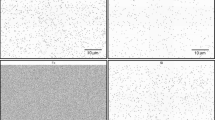Abstract
Small amounts of silicon added to steel act as a deoxidizer and lower the ductile-brittle transition temperature of the steel plate. Larger amounts, depending on the amounts of other deoxidizers already present, become an alloying addition and raise the transition temperature. Increasing aluminum contents up to 0.20 pet lowered the transition temperature at a rate depending on the amount of silicon and manganese present.
Similar content being viewed by others
References
D. C. Hilty and Walter Crafts: The Solubility of Oxygen in Liquid Iron Containing Aluminum. AIME Trans., 1950, vol. 188, pp. 414–424; Journal of Metals, February 1950.
D. C. Hilty and Walter Crafts: Solubility of Oxygen in Liquid Iron Containing Silicon and Manganese. AIME Trans., 1950, vol. 188, p. 425–436; Journal of Metals, February 1950.
N. A. Kahn and E. A. Imbembo: Notch Sensitivity of Steel Evaluated by Tear Tests. Welding Journal, 1949, vol. 28, No. 4, pp. 153s–166s.
J. E. Campbell, R. H. Frazier, and H. O. Mclntire: Ferrite Grain-Size Measurements for Ship Plate Steel. Welding Journal, 1952, vol. 31, No. 2, pp. 78s–94s.
J. W. Halley: Grain-Growth Inhibitors in Steel. AIME Trans., 1946, vol. 167, pp. 224; Metals Technology, June 1946.
W. T. Rogers: Statistical Analysis of the Effect of Alloying Elements on Mechanical Properties of Seamless Tubes. ASM Trans., 1951, vol. 43, pp. 1126–1143.
Andrew McWilliam: Influence of Some Elements on the Tenacity of Basic Steel. Journal Iron and Steel Institute, 1918, vol. 98, pp. 43–55.
Samuel Epstein: Notch Resistance of Carbon Steel Ship Plate. American Iron and Steel Institute, 1951, pp. 139–183 (Regional Technical Meetings).
F. W. Boulger and R. H. Frazier: The Influence of Carbon and Manganese on the Properties of Semikilled Hot-Rolled Steel. AIME Trans., 1954, vol. 200, pp. 645–652; Journal of Metals, May 1954.
J. A. Rinebolt and W. J. Harris, Jr.: Effect of Alloying Elements on Notch Toughness of Pearlitic Steels. ASM Trans., 1951, vol. 43, pp. 1175–1201.
J. A. Rinebolt and W. J. Harris, Jr.: Statistical Analysis of Tests of Charpy V-Notch and Keyhole Bars. Welding Journal, 1951, vol. 30, No. 4, pp. 202s–208s.
R. H. Frazier, F. W. Boulger, C. H. Lorig: Influence of Heat Treatment on the Ductile Brittle Transition Temperature of Semi-killed Steel Plate. AIME Trans., 1955, vol. 203. pp. 323–329; Journal of Metals, February 1955.
W. P. Rees and B. E. Hopkins: Intergranular Brittleness in Iron-Oxygen Alloys. Journal Iron and Steel Institute, December 1952, vol. 172, pp. 403–409.
Author information
Authors and Affiliations
Additional information
TP 4262E. Manuscript, July 11, 1955. Cleveland Meeting, October 1956.
Rights and permissions
About this article
Cite this article
Frazier, R.H., Boulger, F.W. & Lorig, C.H. Influence of Silicon and Aluminum on the Properties of Hot-Rolled Steel. JOM 8, 1269–1276 (1956). https://doi.org/10.1007/BF03377864
Published:
Issue Date:
DOI: https://doi.org/10.1007/BF03377864




